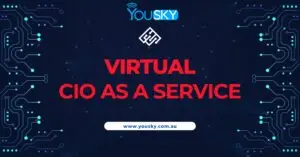
As technology continues to advance at an unprecedented pace, businesses are facing new challenges in navigating this ever-changing landscape. Enter the rise of Virtual Chief Technology Officers (CTOs), who are revolutionizing the way companies approach tech leadership. With their expertise and strategic guidance, these virtual CTOs are helping businesses stay competitive and innovative in today’s digital age.
Virtual CTOs offer the perfect solution for companies that need the expertise of a seasoned technology executive but may not have the resources or need for a full-time CTO. These professionals bring a wealth of knowledge and experience to the table, helping businesses make informed decisions about their technology investments and strategies.
Their impact goes beyond just providing technical advice – virtual CTOs also play a crucial role in driving digital transformation within organizations. They help identify and implement cutting-edge technologies, optimize processes, and improve overall efficiency.
In this article, we’ll explore the rise of virtual CTOs and how they are transforming the way businesses approach tech leadership. We’ll delve into their role, the benefits they offer, and why more companies are turning to these virtual experts to gain a competitive edge. Strap in as we uncover the future of tech leadership with virtual CTOs by our side.
The role of a virtual CTO
The role of a virtual CTO is multifaceted and crucial for businesses navigating the rapidly evolving technological landscape. These professionals bring a wealth of expertise and strategic guidance to the table, serving as a vital link between a company’s technology needs and its overall business objectives.
As a virtual CTO, their primary responsibility is to provide high-level technology leadership and direction, ensuring that a company’s technology investments and strategies are aligned with its growth and operational goals. They act as a trusted advisor, offering insights and recommendations on everything from software development and infrastructure management to cybersecurity and digital transformation initiatives.
Virtual CTOs play a pivotal role in driving innovation within an organization. They possess a deep understanding of the latest industry trends, emerging technologies, and best practices, and they leverage this knowledge to help businesses stay ahead of the curve. By identifying and implementing cutting-edge solutions, virtual CTOs empower their clients to gain a competitive edge and enhance their overall operational efficiency.
Benefits of hiring a virtual CTO
Hiring a virtual CTO offers a range of compelling benefits for businesses of all sizes and industries. One of the primary advantages is the cost-effectiveness of this arrangement. Traditional, full-time CTO positions can be prohibitively expensive, especially for smaller or mid-sized companies. Virtual CTOs, on the other hand, provide the same level of expertise and guidance at a fraction of the cost, making them an attractive option for businesses with limited budgets.
Another key benefit of working with a virtual CTO is the flexibility and scalability they offer. These professionals can be engaged on an as-needed basis, allowing companies to tap into their expertise when it’s most crucial, without the burden of maintaining a full-time executive-level position. This flexibility is particularly valuable for businesses that are experiencing rapid growth or navigating periods of uncertainty, as they can easily scale up or down their virtual CTO support as needed.
Moreover, virtual CTOs bring a diverse range of skills and experience to the table, often having worked with a wide range of clients across different industries. This cross-pollination of knowledge and best practices can be invaluable, as virtual CTOs can draw on their past experiences to identify innovative solutions and strategies tailored to the unique needs of their current clients. This depth of expertise is a significant advantage that can help businesses stay ahead of the competition and adapt to changing market conditions.
Virtual CTO vs. traditional CTO
While both virtual and traditional CTOs share the common goal of driving technology-enabled business success, there are several key differences between the two roles that make virtual CTOs a compelling option for many companies.
One of the primary distinctions is the level of commitment and availability. Traditional CTOs are typically full-time, in-house executives who are deeply embedded within the organization, responsible for overseeing all aspects of the company’s technology strategy and operations. In contrast, virtual CTOs are engaged on a flexible, as-needed basis, providing their expertise and guidance when it’s most crucial, without the overhead of a permanent, high-level position.
Another significant difference is the cost structure. As mentioned earlier, traditional CTO roles can be financially prohibitive, especially for smaller businesses or startups. Virtual CTOs, on the other hand, offer a more cost-effective solution, allowing companies to access the same level of expertise at a fraction of the cost. This makes virtual CTOs an attractive option for businesses that may not have the resources to support a full-time, in-house technology executive.
Additionally, virtual CTOs bring a unique perspective to the table, as they often have experience working with a diverse range of clients and industries. This cross-pollination of knowledge and best practices can be invaluable, as virtual CTOs can draw on their past experiences to identify innovative solutions and strategies tailored to the unique needs of their current clients. This depth of expertise is a significant advantage that can help businesses stay ahead of the competition and adapt to changing market conditions.
Industries that can benefit from virtual CTOs
The benefits of virtual CTOs are not limited to any specific industry; in fact, these professionals can provide immense value to a wide range of businesses and sectors. Here are some of the industries that can particularly benefit from the expertise and guidance of virtual CTOs:
Startups and Small Businesses: Startups and small businesses often face significant challenges when it comes to navigating the complex world of technology. Virtual CTOs can provide these companies with the strategic direction and technical expertise they need to establish a strong technology foundation, optimize their operations, and drive innovation.
Nonprofit Organizations: Nonprofit organizations often operate with limited budgets and resources, making it difficult for them to justify the cost of a full-time CTO. Virtual CTOs can help these organizations leverage technology to streamline their operations, enhance their impact, and achieve their mission more effectively.
Healthcare: The healthcare industry is undergoing a rapid digital transformation, with the integration of electronic health records, telemedicine, and other cutting-edge technologies. Virtual CTOs can assist healthcare providers in navigating this complex landscape, ensuring that their technology investments and strategies align with industry regulations and patient needs.
Retail and E-Commerce: In the highly competitive retail and e-commerce sectors, technology plays a crucial role in driving customer engagement, streamlining operations, and maintaining a competitive edge. Virtual CTOs can help these businesses leverage emerging technologies, such as artificial intelligence and data analytics, to enhance their online presence, improve their supply chain, and deliver a seamless customer experience.
Manufacturing: The manufacturing industry is increasingly relying on advanced technologies, such as automation, robotics, and the Industrial Internet of Things (IIooT), to improve efficiency and productivity. Virtual CTOs can help manufacturing companies identify and implement the right technologies to optimize their operations, reduce costs, and stay ahead of the competition.
How virtual CTOs are revolutionizing tech leadership
The rise of virtual CTOs is transforming the way businesses approach tech leadership, ushering in a new era of agility, innovation, and cost-effectiveness. These professionals are revolutionizing the traditional CTO model by offering a more flexible and accessible approach to technology strategy and implementation.
One of the key ways virtual CTOs are revolutionizing tech leadership is through their ability to provide on-demand expertise and guidance. Unlike traditional CTOs, who are often bound to a single organization, virtual CTOs can work with multiple clients, bringing a wealth of cross-industry knowledge and best practices to the table. This allows them to quickly identify and implement the most effective solutions for their clients, without the constraints of a siloed, in-house perspective.
Moreover, virtual CTOs are driving innovation by helping businesses stay ahead of the curve. With their deep understanding of emerging technologies and industry trends, these professionals are able to proactively identify opportunities for growth and competitive advantage. By implementing cutting-edge solutions and strategies, virtual CTOs empower their clients to differentiate themselves in the market and maintain a competitive edge.
Another way virtual CTOs are revolutionizing tech leadership is through their focus on digital transformation. As businesses across all industries strive to adapt to the rapidly evolving digital landscape, virtual CTOs are playing a crucial role in guiding this transformation. They help organizations identify and implement the technologies, processes, and cultural changes necessary to thrive in the digital age, ensuring that their clients remain agile, efficient, and customer-centric.
Furthermore, virtual CTOs are democratizing access to high-level technology expertise. Traditionally, the services of a seasoned CTO were reserved for large enterprises with deep pockets. However, the rise of virtual CTOs has made this level of strategic guidance and technical know-how accessible to businesses of all sizes, including startups, small and medium-sized enterprises, and nonprofit organizations. This is a game-changer, as it empowers these organizations to compete on a level playing field and unlock their full potential.
Challenges and considerations when working with virtual CTOs
While the benefits of working with a virtual CTO are numerous, there are also some challenges and considerations that businesses should be aware of when engaging these professionals.
One of the primary concerns is the potential for a lack of deep institutional knowledge. Unlike a traditional, in-house CTO who is fully immersed in the company’s culture, operations, and technology ecosystem, a virtual CTO may require more time to fully understand the nuances of a client’s business. This can be mitigated through effective onboarding and communication, but it’s an important factor to consider, especially for complex or highly regulated industries.
Another challenge is the need for clear communication and alignment between the virtual CTO and the client’s internal teams. Without a physical presence within the organization, virtual CTOs must be adept at remote collaboration, ensuring that their recommendations and strategies are effectively communicated and implemented. This requires a high degree of coordination, project management skills, and a willingness from the client’s team to embrace the virtual CTO’s guidance.
Additionally, businesses must be mindful of the potential security and data privacy risks associated with working with a virtual CTO. These professionals may have access to sensitive information and technology systems, and it’s crucial that robust security protocols and data governance practices are in place to protect the company’s assets. Careful vetting of the virtual CTO’s credentials and security practices is essential to mitigate these risks.
Finally, businesses should consider the potential for a lack of long-term commitment or continuity when working with a virtual CTO. These professionals may have multiple clients, and their availability or focus may shift over time. Establishing clear expectations, communication channels, and contingency plans can help ensure a smooth and seamless working relationship.
Finding and hiring a virtual CTO
As the demand for virtual CTOs continues to grow, businesses are faced with the challenge of identifying and hiring the right professionals to meet their technology leadership needs. Here are some key considerations and best practices for finding and hiring a virtual CTO:
Clearly define your technology needs: Before embarking on your search, it’s essential to have a clear understanding of your company’s technology goals, challenges, and the specific expertise required. This will help you identify the right virtual CTO candidate with the necessary skills and experience to address your unique needs.
Leverage your professional network: Tap into your existing network of industry contacts, colleagues, and technology professionals to gather recommendations and referrals for virtual CTO candidates. Personal connections and word-of-mouth can be invaluable in finding the right fit for your organization.
Conduct a thorough vetting process: When evaluating potential virtual CTO candidates, be sure to thoroughly vet their credentials, experience, and track record of success. This may include reviewing their portfolio, checking references, and conducting in-depth interviews to assess their technical expertise, strategic thinking, and ability to work remotely.
Consider cultural fit: In addition to technical skills, it’s important to assess the virtual CTO’s ability to align with your company’s culture, values, and working style. Ensure that there is a good personality fit and that the candidate can seamlessly integrate with your internal teams.
Establish clear communication and collaboration protocols: Before hiring a virtual CTO, work with the candidate to establish clear communication and collaboration protocols, including regular check-ins, reporting mechanisms, and project management tools. This will help ensure a smooth and productive working relationship.
Prioritize ongoing support and feedback: Regularly provide feedback, support, and guidance to your virtual CTO to ensure that they are delivering value and meeting your expectations. This open communication and collaboration will help foster a productive and long-lasting partnership.
By following these best practices, businesses can navigate the process of finding and hiring the right virtual CTO to meet their technology leadership needs and drive their digital transformation efforts forward.
Virtual CTO success stories
The rise of virtual CTOs has already yielded numerous success stories, showcasing the transformative impact these professionals can have on businesses across various industries. Here are a few examples of how virtual CTOs have helped companies achieve their technology and business goals:
Startup Success: A fast-growing tech startup in the fintech industry was struggling to keep up with the rapid pace of innovation and the increasing complexity of their technology infrastructure. By engaging a virtual CTO, the company was able to streamline their development processes, implement robust security measures, and develop a scalable technology roadmap that supported their ambitious growth plans. As a result, the startup was able to secure additional funding, expand their customer base, and solidify their position as a market leader.
Nonprofit Transformation: A nonprofit organization focused on environmental conservation was facing challenges in leveraging technology to enhance their operations and donor engagement. By partnering with a virtual CTO, the organization was able to develop a comprehensive digital strategy, implement cloud-based solutions, and automate several administrative tasks. This not only improved the organization’s operational efficiency but also freed up resources to allocate towards their core mission, leading to a significant increase in their environmental impact.
Enterprise Innovation: A large, established enterprise in the manufacturing industry was struggling to keep pace with the rapid technological changes in their sector. By engaging a virtual CTO, the company was able to identify and implement cutting-edge technologies, such as industrial automation and data analytics, to optimize their production processes and supply chain. This resulted in a significant improvement in their operational efficiency, cost savings, and the ability to deliver innovative products to their customers, helping the enterprise maintain its competitive edge.
These success stories illustrate the transformative power of virtual CTOs, showcasing how they can help businesses of all sizes and industries overcome their technology challenges, drive innovation, and achieve their strategic objectives. As the demand for virtual CTO services continues to grow, more companies are poised to benefit from the expertise and guidance of these versatile technology leaders.
How Yousky can help with virtual CTO services
Yousky, a leading provider of virtual CTO services, is at the forefront of the revolution in tech leadership. With a team of experienced and highly-skilled technology executives, Yousky offers a comprehensive suite of services to help businesses of all sizes navigate the complex and ever-evolving digital landscape.
As a virtual CTO partner, Yousky brings a wealth of expertise and strategic guidance to the table, helping clients identify and implement the right technologies to support their business goals. From developing comprehensive technology roadmaps and digital transformation strategies to optimizing operations and enhancing cybersecurity, Yousky’s virtual CTOs work closely with their clients to ensure their technology investments and initiatives are aligned with their overall business objectives.
One of the key advantages of partnering with Yousky is the flexibility and scalability of their virtual CTO services. Clients can engage Yousky’s virtual CTOs on an as-needed basis, tapping into their expertise and guidance when it’s most crucial, without the overhead of a full-time executive-level position. This cost-effective model allows businesses of all sizes, from startups to enterprise-level organizations, to access the same level of technology leadership and strategic direction.
Moreover, Yousky’s virtual CTOs bring a diverse range of industry experience and cross-pollination of best practices, allowing them to quickly identify and implement the most effective solutions for their clients. Whether it’s leveraging emerging technologies to drive innovation, optimizing workflows and processes, or enhancing cybersecurity measures, Yousky’s virtual CTOs are equipped to help businesses stay ahead of the curve and maintain a competitive edge.
By partnering with Yousky, businesses can unlock the transformative power of virtual CTOs and revolutionize their approach to tech leadership. With their expertise, strategic guidance, and flexible service model, Yousky is poised to help organizations of all sizes navigate the complexities of the digital age and achieve their technology-driven business goals. Contact us to explore about this service.
Unlock the potential of your small or medium-sized enterprise with Yousky’s Virtual CIO (vCIO) as a Service. Designed specifically for businesses in Australia, our vCIO service provides the strategic IT leadership and expertise of a seasoned Chief Information Officer (CIO), without the overhead of a full-time executive.



